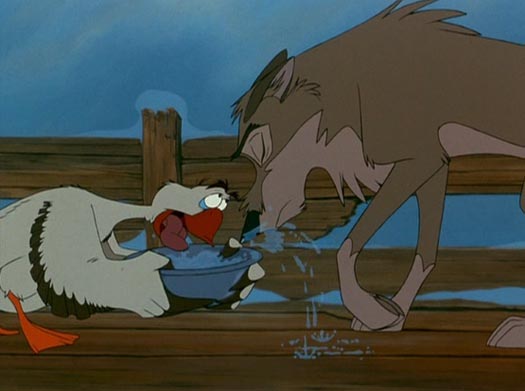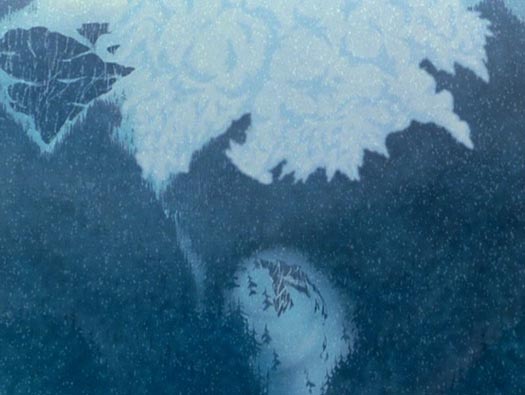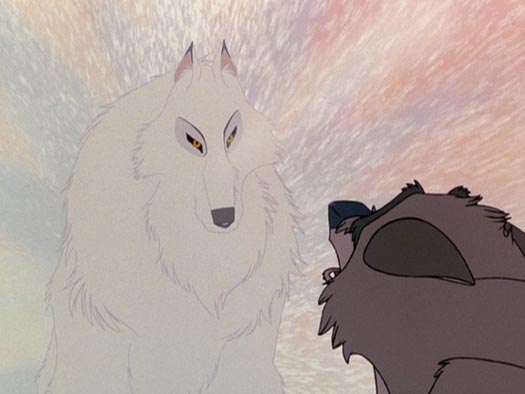Archive for December, 2009
CHILDHOOD REVISITED – A CHARLIE BROWN CHRISTMAS
Posted by kjohnson1585 in Animation, Childhood Revisited, Film, Television, Uncategorized, Writing on December 28, 2009
A Charlie Brown Christmas – (1965)
Director: Bill Melendez
Starring: Peter Robbins, Tracy Stratford, Christopher Shea
Screenplay by: Charles Schulz
Time to end 2009 with a bit of controversy: I think Charles Schulz’ Peanuts is a better comic than Bill Watterson’s Calvin and Hobbes. Don’t get me wrong, both are excellent, iconic strips that defined sense of the human condition through the eyes of surprisingly cognizant children. Calvin, however, seemed more aggressive in dealing with the hardships and realities of the world, able to cope via his imaginary stuffed animal, made-up sports, and exaggerated snowmen. Peanuts had no such outlet. Life sucked, and the children dealt with it.
I think Watterson’s reputation is hinged partially on his isolation and his unwillingness to allow his characters to be marketed or “sold out”. Admirable, certainly, but I believe that if something stands the test of time, no amount of toys, dolls, TV programs, shot glasses, and pillowcases will in no way diminish the impact of the icon (see: the early Simpsons). Besides, it’s not exactly easy to market Peanuts. Other than Snoopy (and maybe Woodstock), you’re not really making dolls of the Peanuts cast. Items derived from the comic are manifested through representing idyllic scenes; calendars, snow globes and posters. You’re not giving a child a stuffed version of a bald, wishy-washy child. (They do make them, I doubt they sell too well.)
More pro-Peanuts later in the piece.
NOSTALGIC LENS: Somehow, Peanuts had always appealed to me, whether it was this special, You’re a Good Man, Snoopy Comes Home, or the weekly strips in my local newspaper. While I wasn’t too much into the educational/religious aspects, I did adore watching Chuck try so hard to just enjoy life, but to have crap happen at every turn. Surprisingly, he still is adamantly perseverant, and perhaps that what made him so appealing to me.
DOES IT HOLD UP: I always imagine the theme of Peanuts to be a rigid determination to stand up against the constant pressures of realities that falls upon even the most innocent members of society. Simply put: “Life fucking sucks, even for children – but fuck it.”
The comics exemplify this the most. The cartoons seem oddly askew to the newspaper strip, however; it’s like comparing Richard Pryor’s stand-up to his film roles. Sure, you can see the similarities, but the material is just an odd shade of the original content. The cartoons tend to be comic series designed in animated form, and for the movies and specials, they still maintain the four-panel style in delivery (bit, bit, bit, PUNCHLINE), but, somehow, have a innate beauty to them, a real sense of melancholy and splendor that pervades the awkward timing and continuity of the actual program.
A Charlie Brown Christmas, the first animated Peanuts show released, showcases all this; its positives (vaguely dark and esoteric humor, intriguing direction by Melendez, a beautiful score by Vince Guaraldi) and its negatives (terrible segues, incomprehensible elements to the story, weak voice work from children) combine to create a child-like sense of whimsy and innocent foray into the true meaning of Christmas.
Charlie Brown reminds me of a young Holden Caulfield. A lost soul trying to find the real meaning of the holiday among the falsities, “phonies,” and commercialization, Brown wakes up depressed for no reason as the kids around him seem more in-tuned into the Christmas spirit. He’s looking for the true meaning, but, why bother? He didn’t get any Christmas cards from anyone. His dog got a free pile of bones. He was chosen to direct the Christmas play, but he sucks at it. What is it all for, Brown wonders?
Linus, the show’s educational mouthpiece, tells us:
Even in 1965, this was ballsy. CBS executives were horrified, seeing such a blatant speech delivered in a Christmas special. Melendez tried to talk Schulz out of it, who apparently convinced him by saying “If we don’t do it, who will?” Melendez and executive producer Lee Mendelson were convinced this would be a flop. But, like a Christmas miracle, it was a hit, the speech becoming the most memorable part of the show. While today the ultra-religious element doesn’t hold up, what with the Hanukkah, Kwanzaa, and other holidays celebrated at this time, the feel of the spirit, espoused in that speech, seems to resonate more than the speech itself.
I think Charlie Brown’s story around the tree is much more resonate and significant to the special’s appeal. When told to get a tree for the play, instead of a fake, metal, colored pine, Charlie Browns grabs a dying real one, a clear reflection of himself and inner troubles concerning the holiday. Of course, he’s un-mercilessly ridiculed for it, but, due to Linus’s speech, he feels that at the very least, he could save it; i.e., save “real Christmas”.
The Peanuts children may embrace the season’s commercialism, but they also have the heart and mindset to understand the season’s abstract meanings of togetherness and spirit. Schulz’s point is that Christmas’s can be both about gifts, products, and advertising (this was originally sponsored by Coca-Cola, after all), and still maintain the importance and impact of the season’s meaning. You can have your cake and eat it too.
This is why I love Schulz. You can be a sellout and still purport beauty and meaning.
IN A NUTSHELL: A Charlie Brown Christmas is as endearing as I remember it. I adore how the show’s essence takes precedent over its flaws; it’s almost like an art film where its nonsensical elements are secondary to the feeling the special exudes. Also, on the DVD, the It’s Christmastime Again, Charlie Brown special was on it. While it wasn’t nearly as rich as the 1965 show, it still was a lot of fun, with an excellently played gag with Sally and a screwed up line.
I will take the month of January off from the CHILDHOOD REVISITED feature, as I will be going on vacation and focusing on a few other writing projects. I will update with current status of how that goes. I will return to this in February, with Willy Wonka and the Chocolate Factory!
CHILDHOOD REVISITED – A GOOFY MOVIE
Posted by kjohnson1585 in Animation, Childhood Revisited, Film, Uncategorized on December 20, 2009
A Goofy Movie – (1995)
Director: Kevin Lima
Starring: Bill Farmer, Jason Marsden, Jim Cummings, Kellie Martin
Screenplay by: Jymn Magon, Chris Matheson, Brian Pimental
Goof Troop wasn’t that good of a show. While the attempt at animated, goofy ,domestic comedy was admirable, it was clear that the writers were better at stories with theoretically no limits. They tried to “wacky-fy” typical household scenarios, plots you’d see in an average sitcom, but without the sense of irony or true freedom to push for true physical humor (anvil drops, explosions, and so on). The DVD had an episode of Goof Troop on it, and while it was better than I expected, its flaws are still as prevalent as before.
So it’s no surprise that none of the show’s writers are credited on A Goofy Movie, a more adult look at the now-teenage son of Goofy, named Max, as he runs the typical route of being himself and accepting/avoiding his embarrassing father. And a cute girl’s in the picture, too, so there’s that. We’ve all seen this kind of thing before.
NOSTALGIC LENS: I don’t think I enjoyed this movie too much, but I did see it quite often, which makes me think there was something I enjoyed about it. I think the animation was rather nice for what it was at the time. There’s a cool, if out-dated dance scene at the end, though.
DOES IT HOLD UP: That irony and self-awareness that wasn’t present in the TV show? Running on all cylinders here. The new set of writers that were tapped to script this movie has a much better handle on the domestic drama, on the complications of father-son relationships, of teenage angst and the role of defining masculinity through nurturing over the years. Well… the Disney version at least.
Loser kid Max Goof pranks the last day of school with a huge mimetic performance of hit R&B singer, Powerline. This prompts a call from his principle to his father, Goofy, er, Goof, who scares him into thinking he’s on a one-way ticket to the electric chair. In a panic, Goofy forces his son on a road trip to bond, in order to influence him to do good things instead of life. Awkward goofy moments follow moments of togetherness and so on. Nothing you wouldn’t see in any other generic bonding film.
Of course, since it’s a Disney film, and it stars Goofy, we’re treated to some fun, wacky moments and typical music. And, since we’re not forced with some Princess that needs to be redeemed or beautified, the moments are more enjoyable than you expect them to be. Decently smooth animation and fluid movements helps in that regard; and can I say I did enjoy the songs a lot? Other than “On the Open Road,” which is more or less a “goofy” tune for some visual and audio humor, and “Nobody Else But You,” a way-too-easy, sum-it-up redemption melody, the music has some engaging 90s-esque sensibilitites. (And even those songs aren’t mind-numbingly grating):
Powerline could be a legit singer if he was real.
For the first half of the film, A Goofy Movie follows the usual plot points and beats, nothing too exciting but fun nonetheless. A particular amusing stop at a possum-themed, hillbilly tourist trap exposes some of Max’s hatred and embarrassment for his father — which is redeemed later when he and his father come together while trapped in their car from a silly yet vicious Bigfoot. It’s interesting to note that the writers do a decent job of keeping the adults’ overall misunderstanding of the teenage lifestyle. The principle, for example, completely confuses Max’s Powerline costume for gang member garb. I know that Twitter may be out his league (also it being 1995), but geez, watch a damn TV show once in a while.
But then, suddenly, the movie shifts, HARD, on a dime, during a moment where Pete and Goofy chat about their respective kids in a hot tub. After the typical high-spirited montage, things take hard edge at a sea-themed motel. Notice at 4:00, the sudden visual darkness and the serious tone the conversation takes. Farmer and Cummings, who spent the bulk of their movie speaking in their comic, sillier voices (Farmer maintains that levity even during the scene where Goofy and Max bond), get, literally, deep in the water.
Cummings delivery, “Hey, my son respects me,” is chilling. There’s a scary undertone here. There’s some implicit questioning and criticisms of the other’s parenting techniques, of how to best raise their child. Goofy doesn’t seem so goofy here; it’s the first time you will ever see him truly worried, concerned, reluctant, or angry. The rest of the movie tries to lighten the mood, but that hot tub scene hangs over every single frame that comes afterwards. This is a good thing, mind you.
The final scene is a little, well, goofy, but it’s too be expected. And the denouement is a sweet, if melodramatic moment where Max gets the girl and has a better acceptance of his father’s behavior. It would be a little overbearing had that hot tub scene not ratchet the drama up to Powerline 11.
IN A NUTSHELL: I was surprised by my overall enjoyment of the film. It seems the weakest element was the entire river/waterfall scene, a mediocre, on-the-nose section dedicated to the mending of relationships. But again, it’s a Disney film, so I’m not railing on it too much– and besides, that motel scene already won the film several points, giving the lesser compelling elements a pass.
December 28th: A Charlie Brown Christmas
CHILDHOOD REVISITED – BALTO
Posted by kjohnson1585 in Animation, Childhood Revisited, Film, Uncategorized on December 14, 2009
Balto– (1995)
Director: Simon Wells
Starring: Kevin Bacon, Bob Hoskins, Bridget Fonda, Jim Cummings
Screenplay by: David Steven Cohen, Elana Lesser, Cliff Ruby, Roger S.H. Schulman
Two weeks of animated canines; just like the past weeks of animated mice and the upcoming foray of animated cats (which will be revealed in time). It’s interesting to not only see how these animals are anthropomorphized, but also how different studios go about their different nuances in the process. Bluth focused on dogs being rebellious, gang/mafia-like scumbags and anti-heroes.; Amblin Entertainment, Spielberg’s animation studio prior to Dreamworks, took a different, Disney-like approach, of pure heroes finding themselves among one evil dog, one female dog, and a number of wacky characters.
The real story of Balto is both interesting and boring. There is a real “moment” of bravery when the canine sniffed out the correct trail while the sled-dog team was crossing some very thin ice. Of course, there’s other details; a dog named Togo ran the toughest, longest section of the relay, for example. All the details can be found here. The info is all over the place, though; IMDB needs a trivia editor, stat.
NOSTALGIC LENS: I had only seen this film once. Maybe twice. I never really had much attraction or enjoyment of the film. It seemed generic, before I even knew what generic meant. Perhaps there’s some subtly that I missed when I was younger that will be a bit more apparent on review.
DOES IT HOLD UP: Meh. Balto is among so many specific-of-its-time 90s films where its conventions and clichés are obvious and apparent. Hell, it’s even book-ended with live-action. Mostly everything and everyone is predictable. And yet, in the 90s, the art of telling the story, no matter how familiar, was so well-defined and refined, that seeing the same general plot rehashed in a different light in little to no way affect the actual enjoyment of the film.
Balto is a half-wolf, half-dog (I think husky but the film never makes it clear) stray who dreams of racing with the actual champion sled-dogs of Nome, Alaska. But his wolf side puts fears and doubts into the humans’ mindset. In addition, Steele, the evil sled dog leader who’s “losing a step,” sabotages every attempt Balto makes to gain their trust. This all happens during a diphtheria outbreak. In the middle of a blizzard, of course.
One of the more awkward issues with a story like this, especially from a writer’s standpoint, is how to rectify the hero’s passion for the “girl” – in this case, a domestic husky named Jenna – and the more grounded necessity to save the day – in this case now, a human girl named Rosie, afflicted with the disease. It comes off that Balto’s desire to get the medicine is less about the outbreak and more about “tappin’ that”. It’s interesting to see how films work that angle. I can’t say this film achieves it one hundred percent, but it does it better than most, especially via the moments when Balto “finds himself”.
The animation is passable; it has a harsh edge to it, which makes the character models kind of boring but really reflects the cold, hard tundra the characters are up against. It’s a nice-looking film, but certainly nothing to sing home about. The voice work is passable; I love this era, when many believed that celebrities could somehow instill their screen-charisma with their voices. Unfortunately, good acting does not equate to good voice work; Kevin Bacon (Balto) and Bridget Fonda (Jenna) do okay, but Jim Cummings as Steele, well, steals the show by strength alone. Cummings has always been one of my favorite voice artists (Billy West is the most talented, but Cummings has a lot of energy, especially as evil characters.) I wish they gave him better dialogue.
The plot follows the usual beats and runs the gamut of wacky moments and intriguing action. Humor is derived from Boris the goose, Muk and Luk (a couple of retarded polar bears), and the sled-dogs. (The raspy-voiced one is actually the best of the entire cast – something about him is very entertaining.) There’s a bear fight. A river breaks apart. Balto and Steele have a “fight”. Nothing new here. In fact, the climax race home is audacious to the point of being silly with the sheer number of “shit” that just happens to make things worse and worse.
Youtube lacks any useful videos, again, so I’ll drop some pictures.
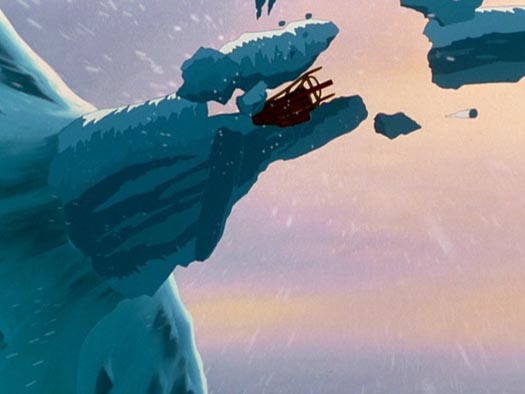
Dangerous, narrow ice bridge that breaks apart when crossing? Check.
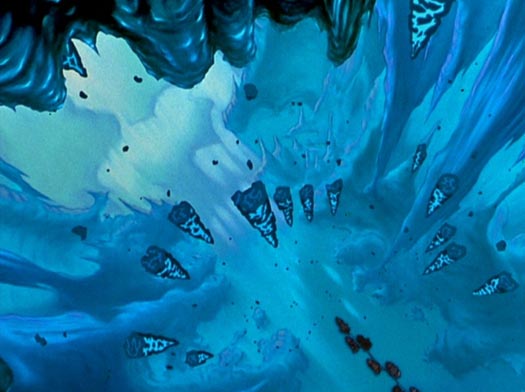
Cave with falling stalactites? Check.

Medicine threatening to fall and shatter? Check.
Only thing that’s missing is a pseudo-vision quest.
Never mind.
IN A NUTSHELL: Balto is pretty decent. Nothing too exciting or mind-blowing, but not boring or mediocre, either. It’s pretty much everything you expect it to be. Yeah, I don’t have any else to say here. I’m going to make me a sandwich.
December 21st: A Goofy Movie
December 28th: A Charlie Brown Christmas


